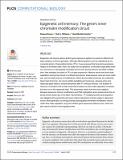Epigenetic cell memory: The gene’s inner chromatin modification circuit
Author(s)
Bruno, Simone; Williams, Ruth J; Del Vecchio, Domitilla
DownloadPublished version (3.063Mb)
Publisher with Creative Commons License
Publisher with Creative Commons License
Creative Commons Attribution
Terms of use
Metadata
Show full item recordAbstract
<jats:p>Epigenetic cell memory allows distinct gene expression patterns to persist in different cell types despite a common genotype. Although different patterns can be maintained by the concerted action of transcription factors (TFs), it was proposed that long-term persistence hinges on chromatin state. Here, we study how the dynamics of chromatin state affect memory, and focus on a biologically motivated circuit motif, among histones and DNA modifications, that mediates the action of TFs on gene expression. Memory arises from time-scale separation among three circuit’s constituent processes: basal erasure, auto and cross-catalysis, and recruited erasure of modifications. When the two latter processes are sufficiently faster than the former, the circuit exhibits bistability and hysteresis, allowing active and repressed gene states to coexist and persist after TF stimulus removal. The duration of memory is stochastic with a mean value that increases as time-scale separation increases, but more so for the repressed state. This asymmetry stems from the cross-catalysis between repressive histone modifications and DNA methylation and is enhanced by the relatively slower decay rate of the latter. Nevertheless, TF-mediated positive autoregulation can rebalance this asymmetry and even confers robustness of active states to repressive stimuli. More generally, by wiring positively autoregulated chromatin modification circuits under time scale separation, long-term distinct gene expression patterns arise, which are also robust to failure in the regulatory links.</jats:p>
Date issued
2022-04Department
Massachusetts Institute of Technology. Department of Mechanical EngineeringJournal
PLOS Computational Biology
Publisher
Public Library of Science (PLoS)
Citation
Bruno, Simone, Williams, Ruth J and Del Vecchio, Domitilla. 2022. "Epigenetic cell memory: The gene’s inner chromatin modification circuit." PLOS Computational Biology, 18 (4).
Version: Final published version